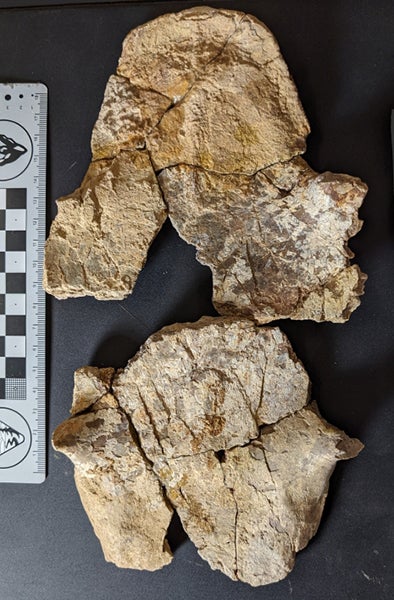Turtles have been on Earth for about 260 million years, making them older than dinosaurs. They can live almost anywhere and scientists can learn a lot about the environments they thrived in and the water quality of those environments, according to Arizona State University PhD student Brenton Adrian.
Brenton Adrian, evolutionary anthropology PhD student
As part of a project before coming to ASU, Brent identified a very old turtle fossil that was in storage at the Arizona Museum of Natural History.
The new fossil species of Cretaceous baenid (extinct turtle) was discovered in the Moreno Hill Formation in the Zuni Basin of western New Mexico, Adrian said. The fossil was discovered in the late 1990s during an expedition led by Doug Wolfe, with the Arizona Museum of Natural History, James Kirkland and volunteers with the Southwest Paleontological Society.
The fossil is about 90 million years old and the turtle lived in an interval of time during the Cretaceous period called the Turonian.
The new species is called Edowa zuniensis. The genus name “Edowa'' is the word for “turtle” in the language of the Zuni Indigenous peoples of western New Mexico and eastern Arizona, and the species name “zuniensis” refers to the Zuni Basin, where the species lived, Adrian explained.
“Edowa would have lived among Zuni Basin dinosaurs, including the tyrannosauroid Suskityrannus, the ceratopsian Zuniceratops and the therizinosaur Nothronychus,” said Adrian, who studies evolutionary anthropology at the School of Human Evolution and Social Change and is affiliated with the Institute of Human Origins.
“The new species fills an enormous gap in our understanding of the evolution of this native group of turtles, and shows that advanced traits evolved significantly earlier and in a wider distribution than previously expected,” he said.

Photo of the type specimen of the fossil itself, showing the preserved turtle's plastron (bottom part of the shell). Photo courtesy Cretaceous Research
The fossil is also remarkable because most of both the top and the bottom part of the shell was found. Adrian explained that turtle shells are made of bone, and the baenid turtle's shell is fused and does not have sutures.
The team was also able to determine this particular turtle was attacked by a crocodile at some point and infected by ectoparasites based on trace fossils on the turtle's shell.
“Turtles are a group that give us a particular insight into the environment at the time,” Adrian said. “Whereas with, for example, a T. rex fossil, we know that they only ate meat and large quantities of it. But with a turtle, they occupied every habitat that reptiles are able to fill for a very long time. So we know how they operate in ecosystems.”
Brent is currently a first-year PhD student and is studying predator-prey dynamics at fossil hominin sites in eastern Africa.
The article, “A new baenid, Edowa zuniensis gen. et sp. nov., and other fossil turtles from the Upper Cretaceous Moreno Hill Formation (Turonian), New Mexico, USA,” was published in Cretaceous Research.
"The specimens were collected on federal lands under a permit from the Bureau of Land Management. These lands are also recognized as the traditional homelands of the Shiwinna (Zuni), Diné Bikéyah and Pueblo peoples,” the research team acknowledged in a press release.
Top photo: Reconstruction of the new species Edowa zuniensis. Illustration by Brenton Adrian
More Science and technology

Transforming Arizona’s highways for a smoother drive
Imagine you’re driving down a smooth stretch of road. Your tires have firm traction. There are no potholes you need to swerve to avoid. Your suspension feels responsive. You’re relaxed and focused on…

The Sun Devil who revolutionized kitty litter
If you have a cat, there’s a good chance you’re benefiting from the work of an Arizona State University alumna. In honor of Women's History Month, we're sharing her story.A pioneering chemist…

ASU to host 2 new 51 Pegasi b Fellows, cementing leadership in exoplanet research
Arizona State University continues its rapid rise in planetary astronomy, welcoming two new 51 Pegasi b Fellows to its exoplanet research team in fall 2025. The Heising-Simons Foundation awarded the…



